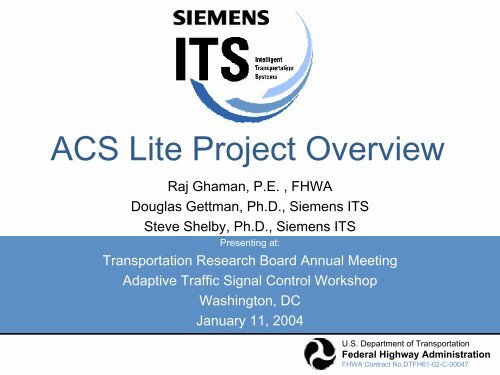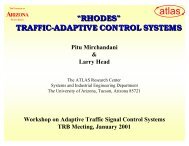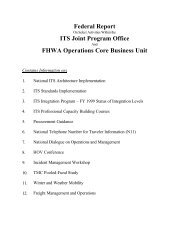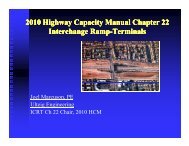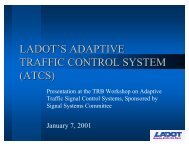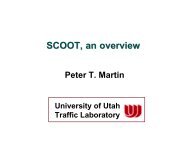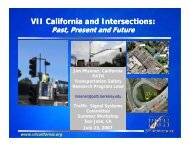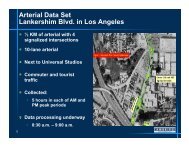ACS Lite Project Overview - Traffic Signal Systems Committee
ACS Lite Project Overview - Traffic Signal Systems Committee
ACS Lite Project Overview - Traffic Signal Systems Committee
Create successful ePaper yourself
Turn your PDF publications into a flip-book with our unique Google optimized e-Paper software.
<strong>ACS</strong> <strong>Lite</strong> <strong>Project</strong> <strong>Overview</strong>Raj Ghaman, P.E. , FHWADouglas Gettman, Ph.D., Siemens ITSSteve Shelby, Ph.D., Siemens ITSPresenting at:Transportation Research Board Annual MeetingAdaptive <strong>Traffic</strong> <strong>Signal</strong> Control WorkshopWashington, DCJanuary 11, 2004U.S. Department of TransportationFederal Highway AdministrationFHWA Contract No.DTFH61-02-C-00047
Outline<strong>ACS</strong> <strong>Lite</strong>TRB - Adaptive <strong>Traffic</strong> <strong>Signal</strong> Control WorkshopWashington, DCJanuary 11, 2004Slide 2<strong>ACS</strong> = Adaptive Control Software• <strong>Project</strong> goals and status• What’s <strong>Lite</strong> about <strong>ACS</strong> <strong>Lite</strong>?• <strong>ACS</strong>-<strong>Lite</strong> system architecture• <strong>ACS</strong>-<strong>Lite</strong> algorithms overview• Performance results• Questions?U.S. Department of TransportationFederal Highway AdministrationFHWA Contract No.DTFH61-02-C-00047
<strong>ACS</strong> <strong>Lite</strong>TRB - Adaptive <strong>Traffic</strong> <strong>Signal</strong> Control WorkshopWashington, DCJanuary 11, 2004Slide 3FHWA’s Motivation for the <strong>ACS</strong>-<strong>Lite</strong> <strong>Project</strong>• Limited U.S. deployment of <strong>ACS</strong>– 8 agencies as of 1999• FHWA <strong>ACS</strong> research– RHODES, OPAC, RTACL• <strong>ACS</strong> survey & ITE roundtable– 70% say <strong>ACS</strong> too costly– 40% unconvinced of benefits over TOD/TRPS– <strong>ACS</strong> too sensitive/dependent on communications & detectors– Difficult to understand, configure, and maintain• Closed-loop systems are prevalent in marketplace– Can we develop an adaptive solution augmenting existinghardware?U.S. Department of TransportationFederal Highway AdministrationFHWA Contract No.DTFH61-02-C-00047
<strong>ACS</strong> <strong>Lite</strong>FHWA’s ASC-<strong>Lite</strong> <strong>Project</strong> GoalsTRB - Adaptive <strong>Traffic</strong> <strong>Signal</strong> Control WorkshopWashington, DCJanuary 11, 2004Slide 4WIDELY DEPLOYABLE adaptive control– Low cost design– Leverage existing infrastructure• Work with closed-loop systems & standard actuated controllers• Standard fully-actuated detector layouts• Communications bandwidth & protocols• Standard NTCIP interface• Field deployable without connection to TMC– Meet performance expectationsU.S. Department of TransportationFederal Highway AdministrationFHWA Contract No.DTFH61-02-C-00047
<strong>Project</strong> Partners<strong>ACS</strong> <strong>Lite</strong>TRB - Adaptive <strong>Traffic</strong> <strong>Signal</strong> Control WorkshopWashington, DCJanuary 11, 2004Slide 6TSIS/CORSIM integration & FHWA TReL testingCharlie StallardController / Closed-Loop <strong>Signal</strong> System VendorsMark HudginsGary DuncanPeter RagsdaleEd BerthaU.S. Department of TransportationFederal Highway AdministrationFHWA Contract No.DTFH61-02-C-00047
<strong>Project</strong> Summary<strong>ACS</strong> <strong>Lite</strong>TRB - Adaptive <strong>Traffic</strong> <strong>Signal</strong> Control WorkshopWashington, DCJanuary 11, 2004Slide 7• Started in March 2002– Siemens ITS, Purdue, Arizona– Upgrade CORSIM (ITT Industries) for NTCIP interface– Partnership with NEMA controller manufacturers• Eagle, Econolite, McCain, PEEK– Focus on arterials in initial phase, networks at a later time• Status– Initial software development complete– Initial simulation evaluation complete– Initial phase final report available March 2004• Coming soon– Hardware-in-the-loop testing at Turner Fairbank <strong>Traffic</strong> Research Lab (TReL)– Field testing with participating NEMA systems– Additional R&D of algorithms and additional componentsU.S. Department of TransportationFederal Highway AdministrationFHWA Contract No.DTFH61-02-C-00047
<strong>ACS</strong> <strong>Lite</strong>What’s “<strong>Lite</strong>” about <strong>ACS</strong>-<strong>Lite</strong>?TRB - Adaptive <strong>Traffic</strong> <strong>Signal</strong> Control WorkshopWashington, DCJanuary 11, 2004Slide 8EffectiveInexpensive<strong>Lite</strong>CompatibleEasy to use“Low-Hanging Fruit”U.S. Department of TransportationFederal Highway AdministrationFHWA Contract No.DTFH61-02-C-00047
System Architecture<strong>ACS</strong> <strong>Lite</strong>TRB - Adaptive <strong>Traffic</strong> <strong>Signal</strong> Control WorkshopWashington, DCJanuary 11, 2004Slide 10<strong>ACS</strong>-<strong>Lite</strong> API(NTCIP-protocol)<strong>ACS</strong>-<strong>Lite</strong>ProtocolTranslationServiceField MasterLaptopVendorspecificprotocolCentral SystemU.S. Department of TransportationFederal Highway AdministrationFHWA Contract No.DTFH61-02-C-00047
<strong>ACS</strong> <strong>Lite</strong>TRB - Adaptive <strong>Traffic</strong> <strong>Signal</strong> Control WorkshopWashington, DCJanuary 11, 2004Slide 11Turner-Fairbank TReL Testing Configuration<strong>ACS</strong>-<strong>Lite</strong> API(NTCIP-protocol)Field MasterCIDControllerInterfaceDevice<strong>ACS</strong>-<strong>Lite</strong>ProtocolTranslationServiceCIDLaptopCentral SystemCIDCORSIMSimulationU.S. Department of TransportationFederal Highway AdministrationFHWA Contract No.DTFH61-02-C-00047
<strong>ACS</strong> <strong>Lite</strong>Current Laboratory ConfigurationTRB - Adaptive <strong>Traffic</strong> <strong>Signal</strong> Control WorkshopWashington, DCJanuary 11, 2004Slide 12<strong>ACS</strong>-<strong>Lite</strong> API(NTCIP-protocol)<strong>ACS</strong>-<strong>Lite</strong>CORSIMSimulationLaptopU.S. Department of TransportationFederal Highway AdministrationFHWA Contract No.DTFH61-02-C-00047
<strong>ACS</strong> <strong>Lite</strong><strong>ACS</strong>-<strong>Lite</strong> Algorithms ArchitectureTRB - Adaptive <strong>Traffic</strong> <strong>Signal</strong> Control WorkshopWashington, DCJanuary 11, 2004Slide 13Time-of-Day TunerTOD Plans- cycle, splits, offsets- pattern switch timesRun-time RefinerTransitionManagementActive Plan- cycle, splits, offsets- active patternPlan Changes- transition methodMasterControllerlocal local local localArterialU.S. Department of TransportationFederal Highway AdministrationFHWA Contract No.DTFH61-02-C-00047
<strong>ACS</strong> <strong>Lite</strong><strong>ACS</strong>-<strong>Lite</strong> Algorithms ArchitectureTRB - Adaptive <strong>Traffic</strong> <strong>Signal</strong> Control WorkshopWashington, DCJanuary 11, 2004Slide 14Time-of-Day TunerTOD Plans- cycle, splits, offsets- pattern switch timesLarge & fastparameter changesRun-time RefinerTransitionManagementActive Plan- cycle, splits, offsets- active patternPlan Changes- transition methodSmooth, incrementalparameter changesFast & non-disruptiveparameter changesMasterControllerlocal local local localArterialU.S. Department of TransportationFederal Highway AdministrationFHWA Contract No.DTFH61-02-C-00047
Run-Time Refiner<strong>ACS</strong> <strong>Lite</strong>TRB - Adaptive <strong>Traffic</strong> <strong>Signal</strong> Control WorkshopWashington, DCJanuary 11, 2004Slide 15• Adjust active timing plan– Cycle (TBD), splits, offsets– Small, incremental adjustments (not permanent -TBD)– Switch earlier or later to next pattern (TBD)• Monitor real-time status– Detector volume & occupancy• Sample every few seconds for cyclic flow profiles• Sample during green, yellow, & red intervals for phase utilization– Actual phase durations of actuated controller– Reasons for termination (max-out, gap-out, etc.)U.S. Department of TransportationFederal Highway AdministrationFHWA Contract No.DTFH61-02-C-00047
<strong>ACS</strong> <strong>Lite</strong>Illustration of Run-Time RefinerTRB - Adaptive <strong>Traffic</strong> <strong>Signal</strong> Control WorkshopWashington, DCJanuary 11, 2004Slide 16Flow(vphpl)12001000800600400200012:00 2:00 4:00AverageDailyDemand6:00 8:00 10:00 12:00 2:00 4:00 6:00 8:00 10:00AMPMTime of DayU.S. Department of TransportationFederal Highway AdministrationFHWA Contract No.DTFH61-02-C-00047
Flow(vphpl)12001000800600400200012:00 2:00 4:00<strong>ACS</strong> <strong>Lite</strong>Illustration of Run-Time RefinerMonth’sHigh-LowRangeTRB - Adaptive <strong>Traffic</strong> <strong>Signal</strong> Control WorkshopWashington, DCJanuary 11, 2004Slide 176:00 8:00 10:00 12:00 2:00 4:00 6:00 8:00 10:00AMPMTime of DayU.S. Department of TransportationFederal Highway AdministrationFHWA Contract No.DTFH61-02-C-00047
<strong>ACS</strong> <strong>Lite</strong>Illustration of Run-Time RefinerTRB - Adaptive <strong>Traffic</strong> <strong>Signal</strong> Control WorkshopWashington, DCJanuary 11, 2004Slide 18Flow(vphpl)12001000800600400200Free012:00 2:00 4:00AM PlanMid-day Plan6:00 8:00 10:00 12:00 2:00 4:00 6:00 8:00 10:00AMPMTime of DayPM PlanFreeU.S. Department of TransportationFederal Highway AdministrationFHWA Contract No.DTFH61-02-C-00047
<strong>ACS</strong> <strong>Lite</strong>Illustration of Run-Time RefinerTRB - Adaptive <strong>Traffic</strong> <strong>Signal</strong> Control WorkshopWashington, DCJanuary 11, 2004Slide 19Flow(vphpl)12001000800600400200012:00 2:00 4:00Today’sDemand6:00 8:00 10:00 12:00 2:00 4:00 6:00 8:00 10:00AMPMTime of DayThis is a perfectlyaverage dayU.S. Department of TransportationFederal Highway AdministrationFHWA Contract No.DTFH61-02-C-00047
Flow(vphpl)12001000800600400200012:00 2:00 4:00<strong>ACS</strong> <strong>Lite</strong>Illustration of Run-Time RefinerRun-Time Refineradjusts active planTRB - Adaptive <strong>Traffic</strong> <strong>Signal</strong> Control WorkshopWashington, DCJanuary 11, 2004Slide 206:00 8:00 10:00 12:00 2:00 4:00 6:00 8:00 10:00AMPMTime of DayRemove excesscapacity of TOD planU.S. Department of TransportationFederal Highway AdministrationFHWA Contract No.DTFH61-02-C-00047
<strong>ACS</strong> <strong>Lite</strong>Illustration of Run-Time RefinerTRB - Adaptive <strong>Traffic</strong> <strong>Signal</strong> Control WorkshopWashington, DCJanuary 11, 2004Slide 21Flow(vphpl)12001000800600400200012:00 2:00 4:006:00 8:00 10:00 12:00 2:00 4:00 6:00 8:00 10:00AMPMTime of DayThis is a perfectly“average” dayU.S. Department of TransportationFederal Highway AdministrationFHWA Contract No.DTFH61-02-C-00047
<strong>ACS</strong> <strong>Lite</strong>Illustration of Run-Time RefinerTRB - Adaptive <strong>Traffic</strong> <strong>Signal</strong> Control WorkshopWashington, DCJanuary 11, 2004Slide 22Flow(vphpl)12001000800600400200012:00 2:00 4:00This is today’s demand6:00 8:00 10:00 12:00 2:00 4:00 6:00 8:00 10:00AMPMTime of DayThis is a perfectly“average” dayU.S. Department of TransportationFederal Highway AdministrationFHWA Contract No.DTFH61-02-C-00047
<strong>ACS</strong> <strong>Lite</strong>Illustration of Run-Time RefinerRun-Time Refinerreallocates time where1200neededFlow(vphpl)1000800600400200012:00 2:00 4:00TRB - Adaptive <strong>Traffic</strong> <strong>Signal</strong> Control WorkshopWashington, DCJanuary 11, 2004Slide 23Better utilizes capacity of streets,but does not build new lanes6:00 8:00 10:00 12:00 2:00 4:00 6:00 8:00 10:00AMPMTime of DayU.S. Department of TransportationFederal Highway AdministrationFHWA Contract No.DTFH61-02-C-00047
Transition Manager<strong>ACS</strong> <strong>Lite</strong>TRB - Adaptive <strong>Traffic</strong> <strong>Signal</strong> Control WorkshopWashington, DCJanuary 11, 2004Slide 24• Manage controllers’ transition from one plan to next– Select existing transition mode• Dwell• Add• Subtract• Best way (of Add/Subtract)– Command sequence of changes (TBD)• Transition Objectives– Timely return to coordination– Minimally disruptiveU.S. Department of TransportationFederal Highway AdministrationFHWA Contract No.DTFH61-02-C-00047
<strong>ACS</strong> <strong>Lite</strong>Illustration of Transition ManagerTRB - Adaptive <strong>Traffic</strong> <strong>Signal</strong> Control WorkshopWashington, DCJanuary 11, 2004Slide 25Offset 1B ADwell OnlyLong WayShort WayOffsetA B2Plan 1A B A B A B A B21 1 1 1B A B A B A B A2 2 2 2Plan 222U.S. Department of TransportationFederal Highway AdministrationFHWA Contract No.DTFH61-02-C-00047
Time-of-Day Tuner<strong>ACS</strong> <strong>Lite</strong>TRB - Adaptive <strong>Traffic</strong> <strong>Signal</strong> Control WorkshopWashington, DCJanuary 11, 2004Slide 26• Periodically re-tune Time-of-day (TOD) plans (TBD)– Adjust cycle, offset, & splits– Changes are “permanent”– Fine-tune schedule of pattern switch times• Benefits– Avoid additional 3-5% delay/year due to changing trafficpatterns– Remain effective during controller comm. failure– Plans tailored to accommodate daily variability– Respond to seasonal changes in traffic conditionsU.S. Department of TransportationFederal Highway AdministrationFHWA Contract No.DTFH61-02-C-00047
<strong>ACS</strong> <strong>Lite</strong>Illustration of Time-of-day TunerTRB - Adaptive <strong>Traffic</strong> <strong>Signal</strong> Control WorkshopWashington, DCJanuary 11, 2004Slide 27Flow(vphpl)12001000800600400200Free012:00 2:00 4:00AM PlanMid-day Plan6:00 8:00 10:00 12:00 2:00 4:00 6:00 8:00 10:00AMPMTime of DayPM PlanFreeU.S. Department of TransportationFederal Highway AdministrationFHWA Contract No.DTFH61-02-C-00047
<strong>ACS</strong> <strong>Lite</strong>Illustration of Time-of-day TunerTRB - Adaptive <strong>Traffic</strong> <strong>Signal</strong> Control WorkshopWashington, DCJanuary 11, 2004Slide 28Flow(vphpl)12001000800600400200012:00 2:00 4:00What if variability changes?6:00 8:00 10:00 12:00 2:00 4:00 6:00 8:00 10:00AMPMTime of DayU.S. Department of TransportationFederal Highway AdministrationFHWA Contract No.DTFH61-02-C-00047
<strong>ACS</strong> <strong>Lite</strong>Illustration of Time-of-day TunerTRB - Adaptive <strong>Traffic</strong> <strong>Signal</strong> Control WorkshopWashington, DCJanuary 11, 2004Slide 29Flow(vphpl)12001000800600400200012:00 2:00 4:00What if variability changes?6:00 8:00 10:00 12:00 2:00 4:00 6:00 8:00 10:00AMPMTime of DayU.S. Department of TransportationFederal Highway AdministrationFHWA Contract No.DTFH61-02-C-00047
<strong>ACS</strong> <strong>Lite</strong>Illustration of Time-of-day TunerTRB - Adaptive <strong>Traffic</strong> <strong>Signal</strong> Control WorkshopWashington, DCJanuary 11, 2004Slide 30Time-of-Day Tuner adjusts tohandle extremes betterFlow(vphpl)12001000800600400200012:00 2:00 4:006:00 8:00 10:00 12:00 2:00 4:00 6:00 8:00 10:00AMPMTime of DayU.S. Department of TransportationFederal Highway AdministrationFHWA Contract No.DTFH61-02-C-00047
<strong>ACS</strong> <strong>Lite</strong>Illustration of Time-of-day TunerTRB - Adaptive <strong>Traffic</strong> <strong>Signal</strong> Control WorkshopWashington, DCJanuary 11, 2004Slide 31Flow(vphpl)12001000800600400200012:00 2:00 4:00What if total flow changes?6:00 8:00 10:00 12:00 2:00 4:00 6:00 8:00 10:00AMPMTime of DayU.S. Department of TransportationFederal Highway AdministrationFHWA Contract No.DTFH61-02-C-00047
<strong>ACS</strong> <strong>Lite</strong>Illustration of Time-of-day TunerTRB - Adaptive <strong>Traffic</strong> <strong>Signal</strong> Control WorkshopWashington, DCJanuary 11, 2004Slide 32Flow(vphpl)12001000800600400200012:00 2:00 4:00What if total flow changes?6:00 8:00 10:00 12:00 2:00 4:00 6:00 8:00 10:00AMPMTime of DayU.S. Department of TransportationFederal Highway AdministrationFHWA Contract No.DTFH61-02-C-00047
<strong>ACS</strong> <strong>Lite</strong>Illustration of Time-of-day TunerTRB - Adaptive <strong>Traffic</strong> <strong>Signal</strong> Control WorkshopWashington, DCJanuary 11, 2004Slide 331200Start AM1000plan 800 earlierFlow(vphpl)600400200012:00 2:00 4:00Permanentlyincrease max greensAdjust TOD plan6:00 8:00 10:00 12:00 2:00 4:00 6:00 8:00 10:00AMPMTime of DayHold AM1000plan 800laterU.S. Department of TransportationFederal Highway AdministrationFHWA Contract No.DTFH61-02-C-00047
<strong>ACS</strong> <strong>Lite</strong><strong>ACS</strong>-<strong>Lite</strong> Algorithms ArchitectureTRB - Adaptive <strong>Traffic</strong> <strong>Signal</strong> Control WorkshopWashington, DCJanuary 11, 2004Slide 34Time-of-Day TunerRun-time RefinerTransitionManagementTOD Plans- cycle, splits, offsets- pattern switch timesActive Plan- cycle, splits, offsets- active patternPlan Changes- transition methodDay-by-DayCycle-by-CycleSecond-by-Second<strong>ACS</strong>-<strong>Lite</strong> is “Appropriately” Adaptivewithin the data/communicationsenvironment of closed-loop systemsArterialMasterControllerlocal local local localU.S. Department of TransportationFederal Highway AdministrationFHWA Contract No.DTFH61-02-C-00047
<strong>ACS</strong> <strong>Lite</strong>Run-Time Refiner Algorithm Details• Splits• OffsetsTRB - Adaptive <strong>Traffic</strong> <strong>Signal</strong> Control WorkshopWashington, DCJanuary 11, 2004Slide 35U.S. Department of TransportationFederal Highway AdministrationFHWA Contract No.DTFH61-02-C-00047
<strong>ACS</strong> <strong>Lite</strong><strong>ACS</strong> <strong>Lite</strong> Split Adjustment GuidelinesTRB - Adaptive <strong>Traffic</strong> <strong>Signal</strong> Control WorkshopWashington, DCJanuary 11, 2004Slide 3612• “EQUISAT” is most popular adaptive split strategy• Volume & model parameters can be unreliable• Use phase timing & termination data (not alone)• Use lane independent green occupancy data• Account for early-return-to-green• Reduce stops with intelligently biased splits• Smart biasing requires arrival profile knowledgeCapacityProgressionU.S. Department of TransportationFederal Highway AdministrationFHWA Contract No.DTFH61-02-C-00047
<strong>ACS</strong> <strong>Lite</strong>Split Adjustment AlgorithmTRB - Adaptive <strong>Traffic</strong> <strong>Signal</strong> Control WorkshopWashington, DCJanuary 11, 2004Slide 37Extend EQUISAT concept to multi-ring controllers• STEP ONE: Form reasonable estimates of degreeof saturation• STEP TWO: Minimize the maximum level ofsaturation on any phase– Ensure barrier alignment & cycle time constraints aresatisfied– Accommodate progression by allowing lower level ofsaturation on coordinated phasesU.S. Department of TransportationFederal Highway AdministrationFHWA Contract No.DTFH61-02-C-00047
Detector Layout<strong>ACS</strong> <strong>Lite</strong>TRB - Adaptive <strong>Traffic</strong> <strong>Signal</strong> Control WorkshopWashington, DCJanuary 11, 2004Slide 38Need detectors at stop-bar of coordinated phasesPhase Utilization DetectorsFlow ProfileDetectorsU.S. Department of TransportationFederal Highway AdministrationFHWA Contract No.DTFH61-02-C-00047
<strong>ACS</strong> <strong>Lite</strong>Multi-ring Controller TerminologyTRB - Adaptive <strong>Traffic</strong> <strong>Signal</strong> Control WorkshopWashington, DCJanuary 11, 2004Slide 39• Barrier group (or just group)– The set of all phases (or ring-groups) between twobarriers (or all phases if there are no barriers)– 2 groups below: {1,2,5,6} and {3,4,7,8}• A ring group is the set of phases on a ring in agroup– 4 ring-groups: {1,2}, {5,6},{3,4}, and {7,8}b1526a3748bU.S. Department of TransportationFederal Highway AdministrationFHWA Contract No.DTFH61-02-C-00047
<strong>ACS</strong> <strong>Lite</strong>Balance saturation within ring-groupTRB - Adaptive <strong>Traffic</strong> <strong>Signal</strong> Control WorkshopWashington, DCJanuary 11, 2004Slide 40• Less split time => higher saturation• More split time => lower saturationBetter splits forphases (1) & (2)Degree of saturation estimatesfor each split allocation(1) 80% (2) 80%MAX80%Original splits forphases (1) & (2)(1) 70%(2) 85%85%Worse splits forphases (1) & (2)(1) 65%(2) 90% 90%! Duration of ring-group "U.S. Department of TransportationFederal Highway AdministrationFHWA Contract No.DTFH61-02-C-00047
<strong>ACS</strong> <strong>Lite</strong>Balance saturation across barrier groupsTRB - Adaptive <strong>Traffic</strong> <strong>Signal</strong> Control WorkshopWashington, DCJanuary 11, 2004Slide 41Degree of saturation estimatesfor each barrier group duration-10+1(1) 80% (2) 85% 85% (3) 70% (4) 85%(1) 80% (2) 80% 90% (3) 70% (4) 90%(1) 75% (2) 80% 95% (3) 70% (4) 95%+10-1! Duration of barrier-group "! Duration of barrier-group "U.S. Department of TransportationFederal Highway AdministrationFHWA Contract No.DTFH61-02-C-00047
Accounting for all rings<strong>ACS</strong> <strong>Lite</strong>TRB - Adaptive <strong>Traffic</strong> <strong>Signal</strong> Control WorkshopWashington, DCJanuary 11, 2004Slide 42Degree of saturation estimatesfor each barrier group duration-10+1(1) 80% (2) 85% 85% (3) 70% (4) 85%(1) 80% (2) 80% 90% (3) 70% (4) 90%(1) 75% (2) 80% 95% (3) 70% (4) 95%+10-1! Duration of barrier-group "-1 (5) 80% (6) 87%0+1(5) 80%(6) 83%87%83%! Duration of barrier-group "(3) 60%(3) 60%(4) 75%(4) 80%(5) 80% (6) 80%Inf.Infeasible+10-1U.S. Department of TransportationFederal Highway AdministrationFHWA Contract No.DTFH61-02-C-00047
<strong>ACS</strong> <strong>Lite</strong>Typical split adjustment profileTRB - Adaptive <strong>Traffic</strong> <strong>Signal</strong> Control WorkshopWashington, DCJanuary 11, 2004Slide 43706050706050Split 4Split 3Split 2Split 1Cumulative Split Time403020Split 8Split 7Split 6Cumulative Split Time403020Split 5101007:00 7:05 7:10 7:15 7:20 7:25 7:30 7:35 7:40 7:45 7:50 7:55 8:00 8:05 8:10 8:15Simulation Time07:00 7:05 7:10 7:15 7:20 7:25 7:30 7:35 7:40 7:45 7:50 7:55 8:00 8:05 8:10 8:15Simulation TimeU.S. Department of TransportationFederal Highway AdministrationFHWA Contract No.DTFH61-02-C-00047
<strong>ACS</strong> <strong>Lite</strong><strong>ACS</strong> <strong>Lite</strong> Offset GuidelinesTRB - Adaptive <strong>Traffic</strong> <strong>Signal</strong> Control WorkshopWashington, DCJanuary 11, 2004Slide 44• Measure cyclic flow profiles directly• Account for travel time from the detector to the signal• Account for variable start of green• Account for both coordinated approaches and effect ondownstream signals• Maximize the total amount of captured flow– Two options:• On inbound and outbound movements at ALL signals on the arterial• On inbound and outbound movements at EACH signal on the arterial independently• Make small incremental changes to minimizetransitionsU.S. Department of TransportationFederal Highway AdministrationFHWA Contract No.DTFH61-02-C-00047
Detector Layout<strong>ACS</strong> <strong>Lite</strong>TRB - Adaptive <strong>Traffic</strong> <strong>Signal</strong> Control WorkshopWashington, DCJanuary 11, 2004Slide 45Need detectors at stop-bar of coordinated phasesPhase Utilization DetectorsFlow ProfileDetectorsU.S. Department of TransportationFederal Highway AdministrationFHWA Contract No.DTFH61-02-C-00047
Local Offset Tuning<strong>ACS</strong> <strong>Lite</strong>TRB - Adaptive <strong>Traffic</strong> <strong>Signal</strong> Control WorkshopWashington, DCJanuary 11, 2004Slide 46Shift to capture most arriving flowOccuancy (%/sec)12010080604020Green Window00 90 180Arrival FlowCycle Counter (seconds)U.S. Department of TransportationFederal Highway AdministrationFHWA Contract No.DTFH61-02-C-00047
<strong>ACS</strong> <strong>Lite</strong>Account for all coordinated approachesTRB - Adaptive <strong>Traffic</strong> <strong>Signal</strong> Control WorkshopWashington, DCJanuary 11, 2004Slide 47120SouthboundOccuancy (%/sec)1008060402000 90 180Cycle Counter (seconds)120NorthboundOccuancy (%/sec)1008060402000 90 180Cycle Counter (seconds)U.S. Department of TransportationFederal Highway AdministrationFHWA Contract No.DTFH61-02-C-00047
<strong>ACS</strong> <strong>Lite</strong>Account for all downstream signalsTRB - Adaptive <strong>Traffic</strong> <strong>Signal</strong> Control WorkshopWashington, DCJanuary 11, 2004Slide 48UpstreamOccuancy (%/sec)1201008060402000 90 180ShiftingearlierreducesstopslocallyDownstreamOccuancy (%/sec)120100806040200Cycle Counter (seconds)0 90 180UpstreamshiftwouldincreasestopsCycle Counter (seconds)U.S. Department of TransportationFederal Highway AdministrationFHWA Contract No.DTFH61-02-C-00047
<strong>ACS</strong> <strong>Lite</strong>Typical offset adjustment profileTRB - Adaptive <strong>Traffic</strong> <strong>Signal</strong> Control WorkshopWashington, DCJanuary 11, 2004Slide 490-10-20Colors representdifferent CORSIMrunsOffset (s)-30-40-50-607:007:057:107:157:207:257:307:357:407:457:507:558:008:058:10Time (min)U.S. Department of TransportationFederal Highway AdministrationFHWA Contract No.DTFH61-02-C-00047
<strong>ACS</strong> <strong>Lite</strong>Simulation Performance TestingTRB - Adaptive <strong>Traffic</strong> <strong>Signal</strong> Control WorkshopWashington, DCJanuary 11, 2004Slide 50• ITT Industries– Developed NTCIP agent interface to CORSIM– Developed multi-pattern capability and realistic transition logic• Purdue– Developed “real-world” test scenarios– Synchro-optimized timings– Many, many, many simulation runs and independent assessment of resultsU.S. Department of TransportationFederal Highway AdministrationFHWA Contract No.DTFH61-02-C-00047
<strong>ACS</strong> <strong>Lite</strong>Simulation Performance TestingTRB - Adaptive <strong>Traffic</strong> <strong>Signal</strong> Control WorkshopWashington, DCJanuary 11, 2004Slide 51• Evaluate algorithms parameters– Re-adjustment intervals (5 to 10 minutes)– Offset changes and max deviations (2 to 20 seconds, “any”)– Split adjustments and max deviations (2 to 20 seconds, “any”)– Results tend towards shorter re-adjustment intervals and largerflexibility of algorithm to make adjustments• Start with optimized timings – can <strong>ACS</strong>-<strong>Lite</strong> improve?• Start with bad/arbitrary offsets or splits – can <strong>ACS</strong>-<strong>Lite</strong> find a good solution?• Change turning proportions and volumes to representreal-world traffic changes – can <strong>ACS</strong>-<strong>Lite</strong> adapt?U.S. Department of TransportationFederal Highway AdministrationFHWA Contract No.DTFH61-02-C-00047
<strong>ACS</strong> <strong>Lite</strong>Simulation Performance TestingTRB - Adaptive <strong>Traffic</strong> <strong>Signal</strong> Control WorkshopWashington, DCJanuary 11, 2004Slide 52Changes in volumes at side-streetapproaches to intersections 2, 4, and 7impact the entire networkVehicleminutesVehicleminutesU.S. Department of TransportationFederal Highway AdministrationFHWA Contract No.DTFH61-02-C-00047
<strong>ACS</strong> <strong>Lite</strong>Evaluation Results – Total Control DelayTRB - Adaptive <strong>Traffic</strong> <strong>Signal</strong> Control WorkshopWashington, DCJanuary 11, 2004Slide 5318000.0AM Scenarios PM Scenarios Off-peak ScenariosBaseline16000.0<strong>ACS</strong>-<strong>Lite</strong>~28% improvement14000.012000.010000.08000.06000.04000.02000.00.0B-1000A-1000B-1111A-1111B-1112-AA-1112-AB-1223A-1223B-1233A-1233B-2000A-2000B-2111A-2111B-2112-AA-2112-AB-2223A-2223B-2233A-2233B-3000A-3000B-3111A-3111B-3112-AA-3112-AB-3223A-3223B-1333A-1333Total Delay (veh-min)SS↓SS↓SS↓SS↑SS↓ SS↓SS↑BaselineBaselineBaselineSS↓ SS SSScenarioU.S. Department of TransportationFederal Highway AdministrationFHWA Contract No.DTFH61-02-C-00047
<strong>ACS</strong> <strong>Lite</strong>Evaluation Results – Phase FailuresTRB - Adaptive <strong>Traffic</strong> <strong>Signal</strong> Control WorkshopWashington, DCJanuary 11, 2004Slide 54454035Synchro Baseline<strong>ACS</strong>-<strong>Lite</strong>Worst CaseTotal Number of Phase Failures:Synchro Baseline: 17<strong>ACS</strong>-<strong>Lite</strong>: 24Worst Case: 88 ~70%improvement30Number of Failures2520151050103-1101-1104-12-1105-21-2106-23-2107-32-3108-34-3109-43-4110-45-4111-54-5112-56-5113-65-6114-67-6115-76-7116-7102-7Approach LinkU.S. Department of TransportationFederal Highway AdministrationFHWA Contract No.DTFH61-02-C-00047
<strong>ACS</strong> <strong>Lite</strong>“Very High Altitude” Evaluation ResultsTRB - Adaptive <strong>Traffic</strong> <strong>Signal</strong> Control WorkshopWashington, DCJanuary 11, 2004Slide 55<strong>ACS</strong>-<strong>Lite</strong> testscenarioStart with optimizedsettingsStart with bad Offsets(no split adjustment)Start with bad side-streetSplits(no offset adjustments andprogression bias)Changing volumes &turning proportionsvs. “Do nothing”,initially as <strong>ACS</strong>-<strong>Lite</strong>Delay (-0.0%, +0.7%)Travel Time (-0.6%,+2.4%)Delay (-4.2%, +0.9%)Travel Time (-4.0%,+1.3%)Delay (-3.3%, +2.2%)Travel Time (-4.9%,+6.8%)Delay ( -28%, -7.4% )Travel Time ( -6.4%, +3.5% )Conclusion<strong>ACS</strong>-<strong>Lite</strong> “does no harm”<strong>ACS</strong>-<strong>Lite</strong> can find a goodset of offsets<strong>ACS</strong>-<strong>Lite</strong> usually makesimprovement<strong>ACS</strong>-<strong>Lite</strong> providesconsistent delay reductionU.S. Department of TransportationFederal Highway AdministrationFHWA Contract No.DTFH61-02-C-00047
Conclusions<strong>ACS</strong> <strong>Lite</strong>TRB - Adaptive <strong>Traffic</strong> <strong>Signal</strong> Control WorkshopWashington, DCJanuary 11, 2004Slide 56• Core <strong>ACS</strong>-<strong>Lite</strong> development is complete– Run-Time Refiner– Transition Manager– Communications and algorithms software infrastructure• Performance evaluation in simulation is encouraging• Current configuration designed for up to 12 intersectionson arterial• Coming up– TReL testing with Hardware-in-Loop– Field testing– Time-of-day Tuner algorithms developmentU.S. Department of TransportationFederal Highway AdministrationFHWA Contract No.DTFH61-02-C-00047
Questions?<strong>ACS</strong> <strong>Lite</strong>TRB - Adaptive <strong>Traffic</strong> <strong>Signal</strong> Control WorkshopWashington, DCJanuary 11, 2004Slide 57Web-basedInterfaceU.S. Department of TransportationFederal Highway AdministrationFHWA Contract No.DTFH61-02-C-00047


